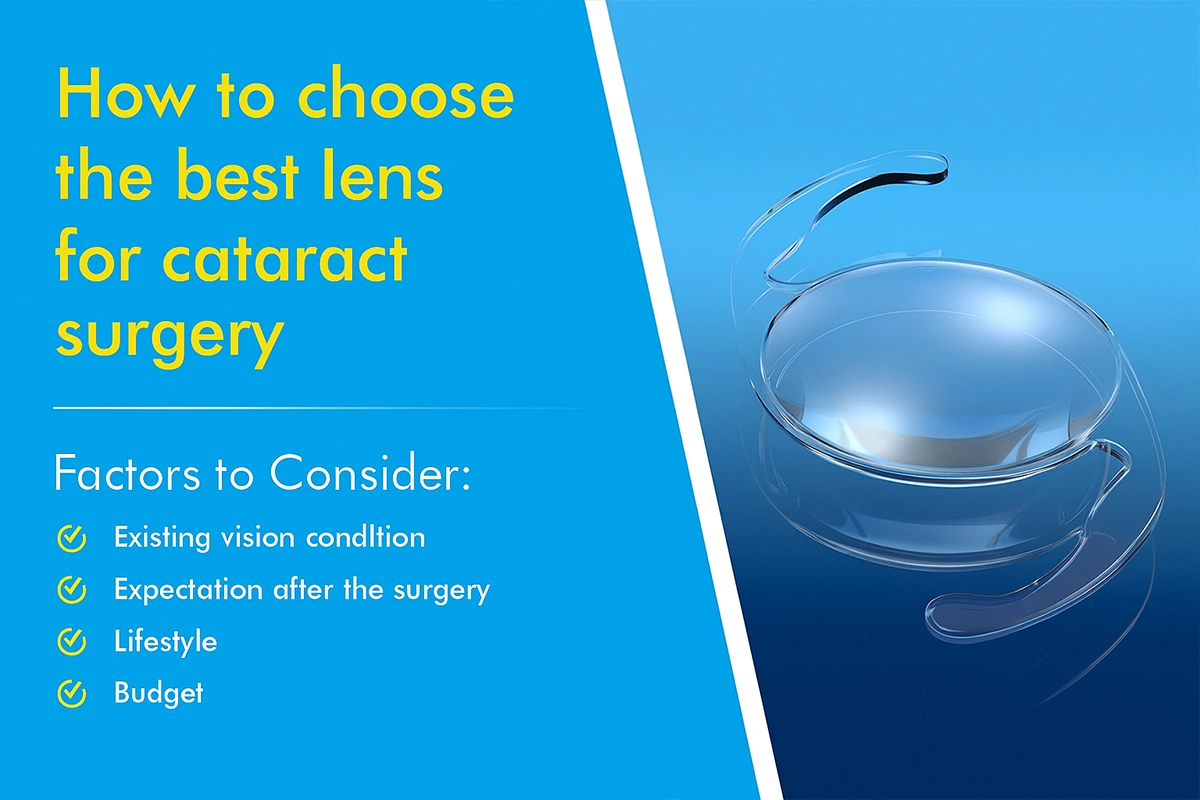Cataract is one of the most common causes of vision loss across the world. Although it usually develops with age, people of any age group can be affected. Cataract gradually clouds the natural eye lens, making vision blurry, and if left untreated, it can eventually lead to complete blindness.
The only treatment for cataract is surgery. During cataract surgery, the cloudy lens is removed and replaced with an artificial lens called an Intraocular Lens (IOL). Since the new lens lasts a lifetime, choosing the right one is an important decision that directly impacts your vision and quality of life after surgery.
So, which type of lens is best for cataract or motiyabind surgery? Let’s understand the available options and how to decide what suits you best.
What is Cataract Surgery?
Cataract surgery is a quick and safe medical procedure in which the affected lens is replaced with an artificial lens (IOL). The operation itself usually takes only 15–20 minutes, although you may spend 3–4 hours at the hospital for preparation and recovery.
Two main methods are used:
- SICS (Small Incision Cataract Surgery): A small cut is made in the eye to remove the cloudy lens and insert the IOL.
- Phacoemulsification (Phaco Surgery): A more advanced technique that uses ultrasound to break up and remove the cataract through a smaller incision. Healing is quicker, and vision outcomes are generally better.
Your eye surgeon will decide the best surgical method depending on the condition of your eyes and the stage of your cataract.
Types of Lenses (IOLs) for Cataract Surgery
IOLs are permanent implants that last a lifetime, so the choice of lens is crucial. The selection depends on your eye health, lifestyle, and budget. Here are the main options:
1. Monofocal Lens
- Provides clear vision at a single distance (usually for distance vision).
- Most common and cost-effective option.
- You will likely need glasses for near work like reading or using a mobile phone.
2. Multifocal Lens
- Offers vision at multiple distances – near, intermediate, and far.
- Reduces or eliminates the need for glasses after surgery.
- More expensive than monofocal lenses.
- Not suitable for everyone, especially those with other eye conditions.
3. Toric Lens
- Designed for patients with both cataract and astigmatism (a condition caused by irregular curvature of the cornea).
- Available as Monofocal Toric (corrects distance vision + astigmatism) and Multifocal Toric (corrects distance, near vision, presbyopia, and astigmatism).
- More costly but essential if you have significant astigmatism.
4. Accommodative Lens
- Works more like the natural lens, adjusting focus when you look at near or far objects.
- Unlike multifocal lenses, they don’t split light but provide smoother focusing.
- May still require glasses for very close work.
5. Extended Depth-of-Focus (EDOF) Lens
- A newer, advanced option that gives a wider range of clear vision.
- Reduces glare and halos, making it better for people who drive often at night.
- More expensive than traditional multifocal lenses.
6. Light-Adjustable Lens (LAL)
- A unique lens that can be fine-tuned even after surgery using UV light adjustments.
- Offers customized vision correction, minimizing glare and halos.
- Requires follow-up sessions with your eye doctor after surgery.
How to Choose the Best Lens for Cataract Surgery
There is no “one-size-fits-all” answer to which lens is best. The right choice depends on multiple factors:
- Budget: Monofocal lenses are the most affordable. Multifocal, EDOF, and Light-Adjustable lenses are more advanced but significantly costlier.
- Lifestyle:
- If you want minimal dependence on glasses, a Multifocal or EDOF lens may be best.
- If you spend long hours driving at night, EDOF lenses are preferable as they reduce halos.
- If you work extensively on computers, multifocal or accommodative lenses may suit you.
- Pre-existing Eye Conditions:
- Astigmatism: Toric lenses are necessary.
- Presbyopia (difficulty focusing on near objects with age): Multifocal or Toric Multifocal lenses can help.
- Expectations: If you are comfortable using glasses occasionally, a monofocal lens might be enough.
Final Word: Which Lens is Best for You?
The “best lens” for cataract or motiyabind surgery depends entirely on your eye health, lifestyle, and budget. While advanced options like Multifocal, EDOF, or Light-Adjustable lenses promise greater freedom from glasses, they are not suitable or necessary for everyone.
It is extremely important to have an open discussion with your eye surgeon. Share your daily habits, work requirements, and vision expectations so your doctor can guide you toward the most suitable lens.
Remember, cataract surgery is not just about removing the cloudy lens – it’s about restoring your eyesight for the rest of your life. Choosing the right lens makes all the difference.

